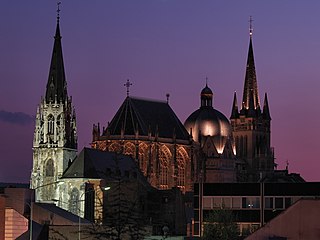
Aachen is, with around 249,000 inhabitants, the 13th-largest city in North Rhine-Westphalia, and the 28th-largest city of Germany.

Aachen Cathedral is a Roman Catholic church in Aachen, Germany and the seat of the Roman Catholic Diocese of Aachen.

Jans der Enikel, or Jans der Jansen Enikel, was a Viennese chronicler and narrative poet of the late 13th century. He wrote a Weltchronik and a Fürstenbuch, both in Middle High German verse.
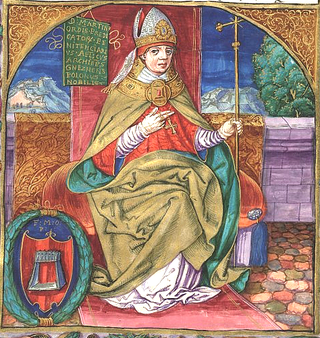
Martin of Opava, O.P. also known as Martin of Poland, was a 13th-century Dominican friar, bishop and chronicler.
The Christherre-Chronik is a 13th-century world chronicle from Thüringen, written in Middle High German rhyming couplets. It was written by a churchman in the service of Henry III, Margrave of Meissen, and may be seen as attempting a spiritual answer to the courtly world chronicle of Rudolf von Ems. The work begins with the creation of the world and was apparently intended to follow world history until the poet's own day, but it was never finished. It breaks off during the account of the book of judges, and in the manuscripts it is continued with text from other chronicles, including (ironically) that of Rudolf, and also sometimes the Weltchronik of Jans der Enikel.
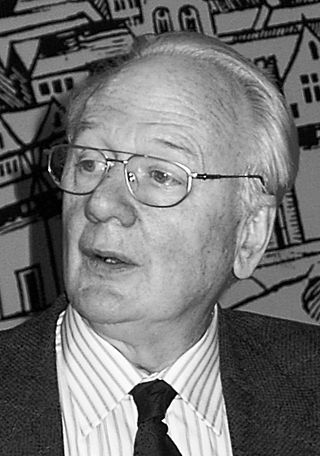
Kurt Malangré was a German politician and lawyer from Aachen. A member of the CDU, he served as Lord Mayor of Aachen from 1973 to 1989 and as a Member of the European Parliament from 1979 to 1999.

Aachener Printen are a type of Lebkuchen originating from the city of Aachen in Germany. Somewhat similar to gingerbread, they were originally sweetened with honey, but are now generally sweetened with a syrup made from sugar beets.
The Lower Rhenish Music Festival was one of the most important festivals of classical music, which happened every year between 1818 and 1958, with few exceptions, at Pentecost for 112 times.

The Aachen tramway network was the backbone of public transport in Aachen, now in the federal state of North Rhine-Westphalia, Germany, and the surrounding areas from 1880 to 1974. The track gauge was 1,000 mm, see Nordrhein-Westfalen.
The Schwabenkriegschroniken are a series of independent accounts written in Switzerland in or shortly after 1499 and recording the history of the war. The main texts are:
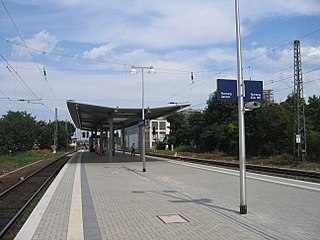
Aachen-Rothe Erde station is a station in the German state of North Rhine-Westphalia on the Cologne–Aachen high-speed railway. It is located in the eastern Aachen district of Rothe Erde near the districts of Frankenberg, Forst and Ostviertel. It is classified by Deutsche Bahn as a category 4 station.
Albert Suho was a cleric and writer. He enjoyed a successful church career in his home town of Osnabrück, and represented the town at the Council of Basel. He wrote a number of theological works in Latin and a world chronicle in Middle Low German.
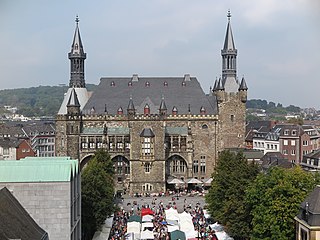
Aachen Town Hall is a landmark of cultural significance located in the Altstadt of Aachen, Germany. It was built in the Gothic architecture style in the first half of the 14th century.
Rothe Erde is a district of Aachen, Germany with large-scale development in heavy industry. It is sub-district 34 of the Aachen-Mitte Stadtbezirk. It lies between the districts of Forst and Eilendorf.
Heinz Hubert Baumann was a German Roman-Catholic priest in Aachen.
The Annals of Aachen is an anonymous late 12th-century compilation of Latin annals from St Mary's Church in Aachen. The annals were originally compiled in 1169 and subsequently extended down to 1196. The first part is little more than a list of Roman emperors from AD 1 until 684. Entries for the years 688–809 were borrowed from some Carolingian imperial annals and are closely related to the Annals of Saint-Amand. There follows a list of Carolingian and German rulers down to 1109. The reports on the reign of Henry V (1105–1125) are generally positive. The coverage of the Staufer rulers is also positive.

The Antoniusstraße is one of the oldest streets of in the centre of Aachen, North Rhine-Westphalia, Germany. It is known for window prostitution.
Graeme Dunphy is a British professor of translation.

Rudolf Pohl was a German Catholic prelate, musician, and choral conductor based at the Aachen Cathedral, where he led the Aachener Domchor to international recognition and revived a school for its boys' choir. He edited sacred music by Johannes Mangon, who had worked at the Cathedral in the 16th century.
Heinrich von München is author-persona of a 14th-century chronicle written in a series of versions in Middle High German verse. Largely a compilatory work, it copies or reworks vast chunks of text from earlier verse chroniclers, supplementing these with new material, and thus offers the longest and most comprehensive account of world history which had ever been written in the German language.











